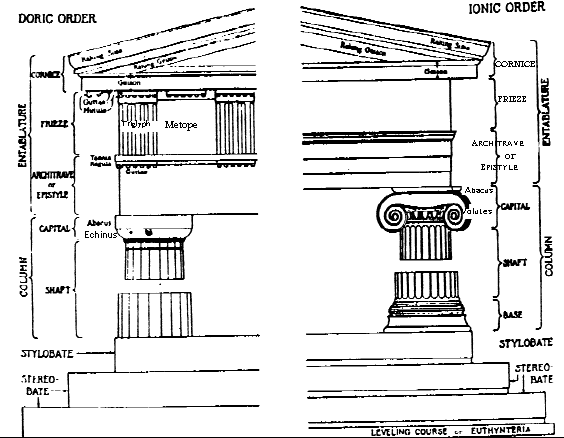Structure of the Greek temple
The oldest place of worship of the Hellenic people is the Mégaron, a large rectangular hall preceded by a vestibule, the ancestor of the greek temple.
From the primitive meaning as main hall of the house, the term has gone on to indicate in the archaeological language an elongated rectangle shaped dwelling, with an open vestibule, present in the Aegean area since prehistoric times.
In the palaces of Mycenae it consisted of a rectangular room, preceded by a vestibule, with a central hearth delimited by four columns and a throne on a side wall. From the micenic megaron, then associated with the peristyle, derives the form of the Greek temple cella.
Parts of a greek temple
A temple consists of a central rectangular part, cella or Nàos, and an atrium or vestibule called pronaos. The cell housed the statue of the deity. A vestibule, opisthodomos, was usually in the back, used for the conservation of sacred objects.
A Doric temple of Selinunte features a cell consisting of a narrow and long rectangular room, ending in a adyton, accessible only from the cell.
The adyton was a space mostly for religious functions of worshipers.
The term témenos refers to the sacred place relevant to a sanctuary and its enclosure.
A propylaeum is a portico in front of the doors of a temple.
The term òikos, instead, means family or home.
An oikos was the basic unit of society, in most of the Greek city-state, and included the head of the oikos (usually the eldest male), his family (wife and children), and the slaves who lived together in a home environment.
The stòa was a long porch for shadowing and indoor strolling or as a public meeting place.
The metope is an architectural element of the frieze of the Doric order of Greek and Roman architecture. It consists of a stone tile, carved in relief, placed alternating with the triglyphs.
A capital, a shaft and possibly a base formed a column. An entablature, in turn composed of architrave (bottom), frieze, and cornice (top) surmounted the column.
Alternating squares filled with triglyphs and metopes decorates the entablature.
With Entasis we indicate an apparent enlargement of the stem of the column, especially in the archaic Doric column. It is apparent because in the Greek column the lower diameter is always the largest.
Kind of temples
Temples of small proportions are in antis. This means the perimeter walls of the cell end with a pronaos with two doors which frame columns.
Distyle in Antis is a temple where doors are also in the opisthodomos.
A prostyle is a temple where a row of columns precedes the façade.
When the row of columns repeats also in the back it is an amphiprostyle.
A colonnade, the peristasis, usually surrounds the cell. Peristatis forms a long perimeter portico, the peristyle.
The temple is peripteral when a row of columns delimites it.
Dipteral if two rows of columns bounds it.
But it is a pseudo-peripteral if the columns are tied to a wall.
Finally, depending on the number of columns on the façade, the temple can be tetrastyle, hexastyle, octastyle, enneastyle, decastyle. Respectively if the façade contains 4,6,8,9, or 10 columns.
In the archaic temples, the number of columns on the sides is generally twice the number of columns on the façade. In the classical temples, the side columns are double, increased by one unit, of the columns of the façade.
Photo of Segesta temple: Maria Virzì
